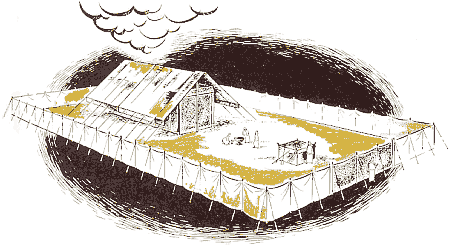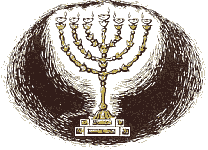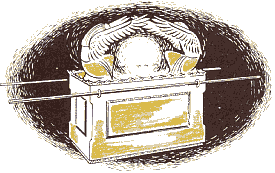BUILDING A HOUSE FOR GOD
THE Law which God wanted the Israelites to obey was written by him and given to Moses on two flat pieces of stone, called “tables of stone.” In those days the people didn’t have typewriters and printing presses. They didn’t have paper, either. So every time it was necessary to write down something that was important to be remembered it had to be done on flat pieces of stone, or on pieces of dried clay.

They didn’t write with ink, either. The writing was scratched or chiseled on the stone or clay. That’s the way the Ten Commandments of the Law were written by God. These Tables of the Law were given to Moses by God while he was up on the mountain called Sinai.
After Moses brought these Ten Commandments down from the mountain, and the people agreed to do what God asked them to do, Moses went up into the mountain again, and God told him to build a tabernacle, and how to do it. Maybe you never heard that word “tabernacle” before. A tabernacle is the name the Bible sometimes gives to a building in which people worship God. It is God’s house.
Of course God doesn’t need a house to live in as we do. God doesn’t sleep, so he doesn’t need a bedroom. He doesn’t need to eat as we do, so he doesn’t need a dining room. God doesn’t get tired, so he has no need for a sitting room. So you see when the Bible tells us about building a house for God we must remember that it was not like our houses.
God’s house, or tabernacle, which Moses was asked to build, was not made of brick or stone. It didn’t have any floor at all. The sides of the tabernacle were made of wide wooden boards which were placed on end. But you wouldn’t think they were wooden boards when you looked at them, because they were entirely covered with gold. The gold was very thin, just like paper, but it covered the boards so completely that it made them look as if they were solid gold. These boards that looked like gold were used to form the walls of the tabernacle.
The tabernacle didn’t have a roof of boards or shingles, or tar, or anything like that. I guess you are wondering how they kept out the rain. That was done by very large curtains which were thrown over the top of the tabernacle. There were four of these curtains. The first one they put on was like a large piece of fancy canvas. Then, over the top of this they spread three other curtains. Two were made by sewing together the skins of different animals—sheep and seals; the other one was made of goats’ hair. These curtains were so large that they not only covered the top of the tabernacle, but also hung down over the sides, covering the gold boards. That meant, you see, that when the tabernacle was finished the only way to see the gold boards that formed the walls was to look at them from the inside.
God’s tabernacle didn’t have a door, either. It had an opening at one end, and this opening was covered with a very pretty curtain of blue, scarlet, and purple. This curtain was called the veil. One had almost to crawl under it in order to enter the tabernacle.
Now I suppose you wonder how big the tabernacle was! It was forty-five feet long, and fifteen feet wide, and fifteen feet high. Inside, it was divided into two rooms by a large curtain which was called the second veil. The curtain covering the entrance from the outside was called the first veil or door. The second veil was fifteen feet front the far end or rear of the tabernacle.
So there were two rooms in the tabernacle. They were not both the same size, though, for the second veil was hung only, fifteen feet from the rear end. Now, if you figure that out you will see that the rear room was only half as large as the front room. The front room was called the “holy,” and the rear room was called the “most holy.”
Most people today like to have their houses surrounded by shade trees, and green grass, and flowers; but God told Moses to stretch a long white curtain all around the tabernacle and in that way to form a big yard, or open space, in which the tabernacle was to stand. This large open space enclosed with white curtains was called the “court.”
The court was 150 feet long and 75 feet wide. The tabernacle was placed toward the back part of the court with the opening, or first veil, facing the entrance. The entrance into the court was called the “gate.” This “gate” was also a beautiful linen curtain of blue, purple, red, and white.
I suppose you are wondering if there was any furniture in God’s house. There was, but not the kind of furniture we have in our homes, because God did not live in his house is we live in ours. But it did have what we may call furniture. Even outside of the tabernacle, in the court, there were two very important articles of furniture. Near the gate in the court was the “brazen altar.”
You remember that we first learned about altars in the story of Cain and Abel. Abel, you will recall, made in altar on which he offered a sacrifice to God. That is what altars were for; they were places to offer sacrifice. This large altar in the court was made of wooden boards covered with sheets of copper.
After passing the altar in the court, one came to what looked like a large water basin. That is really what it was, but it wasn’t called a basin. It was called a “laver.” There was water in the laver, and those who served in the tabernacle used it when they washed themselves.
In the front room of the tabernacle, which was called the “holy,” there were three pieces of furniture. On the right, just as one entered, was a small table. On this table there were two plates of bread, called “shewbread.”
On the opposite side of the room there was a large and beautiful candlestick, or lamp stand. It had seven lamps which were kept burning all the time. If these lamps were not burning, it was very dark in this front room of the tabernacle, because there were no windows.

And then, at the far end of the holy, or front room, directly opposite the entrance, was the golden altar. This altar was much smaller than the one outside in the court, and it was covered with gold instead of copper. The table and the candlestick were also gold.
So you see, all the furniture in the front room of the tabernacle was of gold. With the gold furniture the gold boards of the walls, it must have been a very beautiful room, don’t you think?
In the most holy of the tabernacle, that is, in the far room, which was entered by crawling under the second veil, there was just one piece of furniture. It was called the “ark of the covenant.” It was about the shape of a large trunk. It also was entirely covered with gold. The cover of this large box was made of solid gold.

Extending out of that cover, and made of the same piece of gold, there were two beautiful statues like angels. They were called cherubim. They faced each other, and at the same time were looking down toward the cover of the ark. This cover was called the mercy seat.
There were no windows in the most holy, either, and no lamps such as there were in the holy. So how do you suppose the most holy was lighted? Oh, that was a wonderful thing! Between the cherubim, right over the mercy seat, a bright shining light was put by God. It must have been something like lightning, only instead of being just a short flash of light, it remained there all the time. No one had to keep it burning. It was God’s light!
This tabernacle was God’s house. Of course, God did not actually live in the tabernacle, but the Hebrews knew that they enjoyed God’s blessings because the tabernacle was in their midst. So they thought of God as being in the tabernacle. To them it was the house of God, the place where they could find God. They knew that they could always find God in the tabernacle. Sometimes we can’t find our friends because they are away from home, but God was always at home in the tabernacle.
Of course they couldn’t see God. Nobody on this earth has ever seen God. And when I say that God was always at home in the tabernacle and that the people could find him there, I mean that it was in the tabernacle that they could find God’s blessings. But there was only a certain way in which the people could obtain God’s blessing in the tabernacle. The Israelites could not walk right into the tabernacle and talk with God. Oh, no! There were only certain ones whom God selected to do this, and even these had to come to God in a very special way.
They were called the “priests.” The first priest was Aaron, the brother of Moses. He was called the high, or chief priest. Aaron’s sons were also priests, but less important ones. They were called “under priests.” When the people wanted blessings from God they had to receive them through Aaron, or whoever the priest was. And, even then, there was only one way to receive blessings, and that was by bringing a sacrifice to God. That was the purpose of the large altar in the court surrounding the tabernacle. The sacrifices were burned on this altar.
Now why were these sacrifices necessary? It was because the Israelites were sinful. Like everyone else in the world, they could not do things as God wanted them to be done.
As you read all these stories of the Bible I want you to remember this lesson, that in order for any of us to receive blessings from God there must first be a sacrifice. Will you try to remember that? Because God loves us all he gave his own Son, Jesus, who sacrificed himself for the whole world. Wasn’t that wonderful? Whenever you hear anyone say that Jesus died for us, you will know what it means.
The sheep and calves which the Israelites brought to Aaron at the tabernacle to be sacrificed were not actually valuable enough to take away their sins. The reason God wanted them to bring the sacrifices was to teach a lesson. The lesson God wants us all to learn is that we can have his blessings only if we come to him through Jesus, and that this is because Jesus sacrificed his life for us. Let us try to remember that, shall we?
It would take too long to tell you about all the sacrifices of the tabernacle, so I will just tell you about the most important one. This main sacrifice was offered once every year. This is the way it was done:
First, Aaron took a young calf, which the Bible calls a bullock. He killed it, and certain parts of it, like the heart and the liver and the fat, were burned on the altar in the court. The main carcass of the animal was burned outside of the court. The blood of this bullock was taken by Aaron all the way into the most holy and sprinkled on the mercy seat which covered the ark of the covenant.
On his way to the most holy, the priest stopped long enough at the small golden altar to make an offering of incense. This incense was a sort of powdered perfume which the priest sprinkled upon coals of fire brought from the altar out in the court. The burning of the incense caused a sweet-smelling smoke to drift into the most holy ahead of the priest.
After the bullock was offered in this way, Aaron killed a young goat and did the same thing with it as he did with the bullock, finally sprinkling its blood upon the mercy seat in the most holy.
Now, as I was telling you, all this is a lesson to teach us about something much more wonderful than the offering of bullocks and goats. The Bible tells us that the most holy of the tabernacle represents heaven itself, which is God’s real home. When Jesus died upon the cross and was raised from the dead, he entered into heaven, and God was so pleased with the sacrifice he had made, that now if we pray to God in the name of Jesus we will be heard, and God will bless us.
That is why the cover of the ark of the covenant in the most holy was called the mercy seat. It teaches us that because Jesus shed his blood for us, God in his mercy will bless us, and give us everlasting life. God has always loved the people, but he wants us to know that there is only this one way that we can be blessed with his love.
I wonder if you still remember that grand promise God made to Abraham that he intended to bless all the people of the world? Well, the lesson of the tabernacle and its sacrifices is to remind us that these blessings which God has promised will come through Jesus. They will come true because Jesus died for us.
Maybe you are wondering why the priest sacrificed two animals, first the bullock, and then the goat. It was because God planned to give some of us an opportunity to sacrifice our lives just as Jesus did. Everyone who has really followed Jesus has sacrificed his life, because he loves other people and wants to help them. All those who do this will have the opportunity, when they are made alive again, as Jesus was, to work with him in giving life to the people. Wouldn’t you like to be a follower of Jesus when you grow up? Wouldn’t it be wonderful to use all your time in doing things for others?
QUESTIONS
- What was the tabernacle? Who built it, and for what was it used?
- What were the sizes of the rooms in God’s house, and did they have furniture in them?
- What is an altar, and for what purpose is it used?
- Who did the work of God in the tabernacle?